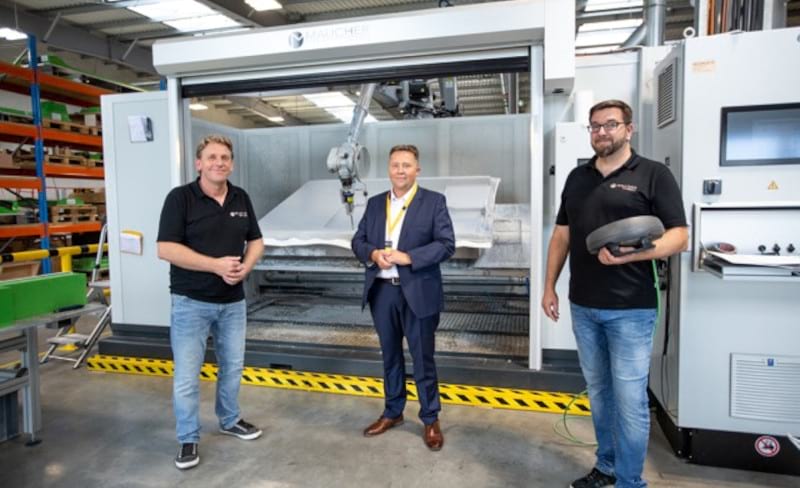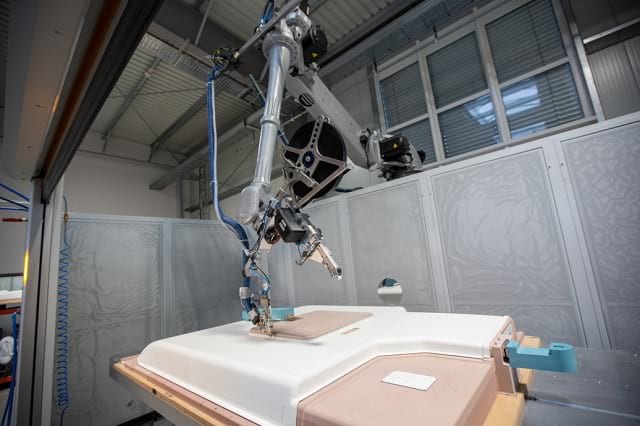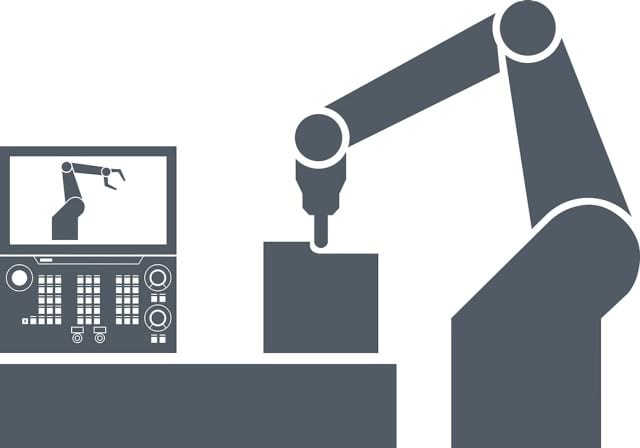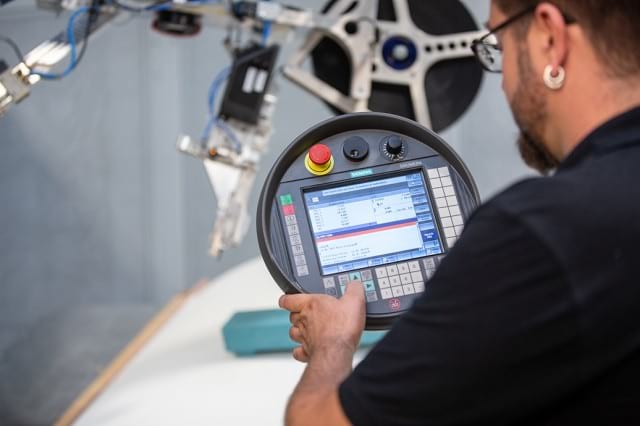Maucher CNC-Robotic GmbH in cooperation with Siemens is about to revolutionize many areas of CNC production. CNC-controlled standard robots handle tasks such as bonding, hook-and-loop fastening, water jet cutting, deburring, riveting, and other activities in machining cells. The innovative robot cells have been performing well in practical applications at the automotive supplier Maucher Formenbau for many months now. In the meantime, Maucher is offering the CNC robotic solutions initially developed for in-house production to other customers as well.
A robot machines workpieces in several work spaces
The employee at Maucher Formenbau GmbH takes the blank for the vehicle roof liner out of the press. For the purposes of precutting, he places the roof liner on a mold which is clamped onto a workpiece table in an otherwise empty cell. The door of the cell closes and the operator starts the NC program on the CNC using a mobile operator panel. The robot arm then moves into the cell from above. Accompanied by seemingly effortless movements of the robot arm and workpiece table, the robot moves precisely over the complex curves of the mold and over all cutouts with a nozzle for water jet cutting. No sooner is this task finished than the robot arm moves up out of the cell and lowers itself into an adjacent cell where another employee has placed a different molded component for precutting.
Continuous-path-controlled, precise machining by robot
What looks so unspectacular and commonplace in the production facility at Maucher Formenbau is actually a minor revolution in robotics and CNC production. “I actually worked in the development and commissioning of robotic applications for many years. Robots were previously limited to handling tasks as they were controlled by point-to-point systems. Using them to perform more complex or more precise machining operations was impossible”, Dirk Brissé, Managing Director of Maucher CNC-Robotic GmbH.
Then a former colleague Patrick Bartsch called him up and told him that he wanted to develop robots which could be used for machining. “I instinctively turned him down. But then I got quite excited about the idea and the very next day I agreed to get involved”, says Dirk Brissé.
SINUMERIK Run MyRobot: an electrifying idea
The two innovation-hungry partners then went knocking on the doors of many robot manufacturers with their idea. However hardly anyone really shared their enthusiasm – probably because the robotics business was booming and huge revenue from simple handling operations was already on the cards for manufacturers.
“Then we heard about Comau and its integration in SINUMERIK Run MyRobot. Here too, the primary application field was handling, but the Comau robot was controlled by the CNC and was synchronized with the machine tool in this way. And here’s what really electrified us: the Siemens developers had integrated the kinematics of the Comau robot in the CNC, thus establishing a continuous-path control for robots. And on top of this: the robot could benefit from all the advantages of the SINUMERIK 840D sl: digital twin, machining simulation, integrated safety, programming via CAD/CAM software, etc. etc.”
This means that a robot specialist is no longer necessary for programming machining tasks. In future, the CNC experts in production with all their knowledge about production processes and materials could do the job.
In-house production as a test bay
The two developers then also got Peter Strittmatter, Managing Director of the automotive supplier Maucher Formenbau GmbH, interested in their idea: “Our sphere of activity involves supplying roof liners, mats, wheel arch liners and hybrid materials for small production runs, luxury brands and special vehicles, such as armored limousines. Flexibility is required here – coupled with high quality. The crux of the issue is as follows: special-purpose machine manufacturing is hardly worthwhile with these quantities and we come up against our limits with respect to output, quality, efficiency and ergonomics for our employees if our processes are purely manual. I found the idea of using precise and flexible robots for machining and being able to program them like a CNC extremely exciting”.
Fiddly and physically demanding: precisely sticking the hook-and-loop tape to soft material
In the meantime, complete solutions that were developed based on the idea have been doing a reliable job at the Maucher production facility for a number of months now. Not very far away from the multi-cell plant for water jet cutting, there is a cell where a robot with a multi-application head is being used to apply adhesive and hook-and-loop tape to the vehicle roof liners.
These will later be used to fasten the roof liners to the bodywork. A dispenser nozzle on the robot arm first applies long lines or individual spots of adhesive. After each complete path, the robot head performs a small rotation, moves back along the lines and spots once again and applies hook-and-loop tape from a large roll on the head, presses this down and cuts it to size – all perfectly controlled by a SINUMERIK 840D sl.
“This work requires precision and was also extremely demanding physically for our employees due to the pressure that had to be applied. We even had the basic problem of employees not being able to reach far enough when it came to roof liners for vans and minibuses. Now this task is performed automatically – for a large number of different roof liners and vehicle types”, says Peter Strittma
Complete solutions with calculable costs
You realize how important practical experience is when you see that the two developers only came up with the idea of positioning the robot not in the cell but instead above the cell on a frame positioned to the side when they were working on the practical application. This saves space – both for the footprint and in the work space of the machine tool. It allows one robot to operate in several cells without too much effort, thereby optimizing setup times.
“This is another difference compared with normal robot manufacturers. We are not starting up any time-consuming and risky robot projects. We are simply offering complete solutions with calculable costs. Using our own production facility as a test bed, we develop a process solution which we can then deliver as a finished product comprising a standard cell, standard robot, the SINUMERIK controller and CE approval for the entire unit.”
Fits on a truck fully assembled
Even the largest fully assembled cell can fit on a truck. The cells can be set up at the production facility in only a few hours. Even with applications like water jet cutting, robots and cells only have to be erected. No special anchors or foundations are required. From a process engineering standpoint, the cell constitutes a classical CNC machine tool after it has been set up. Programs can be created and simulated in the usual digital sequence using CAD/CAM programs; tools and clamping devices are automatically tested – and the “Integrated Safety” functions of SINUMERIK are also operational.
So far, this is all familiar territory. But the robot cells also open up new possibilities. The eight axes permit new and more efficient machining strategies and shorter cycle times – in some processes up to 30 percent better than classical 5-axis machine tools. Robots and cells can be used for different tasks depending on the application head. The investment protection is also impressive: “If a process or machine becomes obsolete due to changes in the order books, I can retrofit the robot for other processes”, says Peter Strittmatter.
And I never need a robot expert and I never have to train my people for new applications and programming languages. The whole thing is based on the G code which we are already familiar with. Programs can easily be created or adapted in-house on a CAD/CAM workstation – by people who do that type of work anyway
Peter Strittmatter, Managing Director of automotive supplier Maucher Formenbau GmbH
What happens next? Robotic applications for other customers
For the past few months, Maucher is no longer just building robotic systems for in-house production but also for other customers based on the Comau Run MyRobot project implemented with SINUMERIK 840D sl. Robot cells for applications which have already been running for some time at Maucher Formenbau are the primary focus at the moment. However other applications are being developed simultaneously for the innovative field of CNC robotics. “The most interesting applications for us at the moment are machining applications which can get by with smaller payloads. We are currently testing robot cells for processes such as polishing and deburring for example. The demand for this application is increasing, especially for composite materials, and it can also be implemented using robots for small and medium payloads”, explains Dirk Brissé.
“CNC robotics with SINUMERIK and Run MyRobot is perfect for initially synchronizing robots on machine tools with the machining processes – without the need for any specialized robotics programmers. In addition to handling tasks, the CNC-controlled robot can also perform premachining or parallel machining operations. This results in added value for the plant concept as well as shortening of production times. Examples like those at Maucher and initial prototypes with mobile robots in aircraft manufacturing also make it clear that CNC robotics also has huge potential in the field of machining. We are only at the start of the journey here – for example when it comes to the development and programming of 8-axis machining. I am impressed by the flexibility and the slimline setup of the robot cells offered by Maucher CNC-Robotic GmbH based on SINUMERIK 840D sl – and by the fact that the programming can be carried out by CNC experts in the usual, proven processes”, says Oliver Freisler, who is providing Siemens support to the developers in Friedrichshafen.




